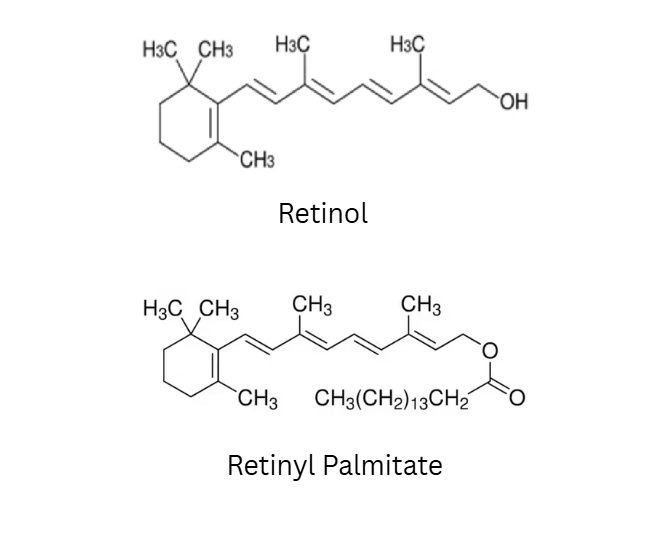Skin photoageing, accelerated by ultraviolet (UV) radiation, is a significant dermatological concern characterized by DNA damage, collagen and elastin degradation, free radical production, uneven pigmentation, laxity, wrinkles, and other skin issues. While retinol (RT) and retinyl palmitate (RP) have individually demonstrated therapeutic efficacy against skin ageing, their applications are limited by retinol’s high irritation potential and retinyl palmitate’s relatively modest effects. To overcome these limitations, this study explores the synergistic effects and biosafety of combining retinol and retinyl palmitate (RP&RT) in repairing UV-induced skin ageing. The rationale behind this approach lies in the potential for RT and RP to complement each other’s actions, enhance therapeutic outcomes, and improve the overall safety profile of retinoid formulations. By potentially reducing the concentration of highly irritant RT and leveraging the combined strengths of both compounds, this study aims to provide a more effective and tolerable anti-photoageing strategy.
Methods
This research employed a comprehensive approach involving in vitro cell experiments using HaCaT cells, in vitro hemolysis assays to assess biosafety, UV-irradiated mouse models for in vivo evaluation, and molecular simulation techniques. The in vitro studies included cell migration assays and PPAR-α expression analysis. The in vivo study involved applying RT, RP, and RP&RT to the back skin of UVB-irradiated mice, followed by histological analyses (H&E, toluidine blue, Masson staining) and immunohistochemistry for key ageing markers. Furthermore, metabolomics and transcriptomics analyses were conducted on skin tissue to understand the underlying mechanisms of the combined treatment. Network pharmacology and molecular docking were used to explore potential synergistic interactions at the molecular level.
Key Findings
•The combined treatment of RT&RP significantly accelerated cell migration rates in UV-damaged HaCaT cells and showed superior efficacy compared to RT alone, indicating a synergistic effect without increased cellular stimulation.
•RP monotherapy more effectively upregulated PPAR-α expression in UVB-damaged HaCaT cells compared to RT, and the combination of RT&RP further surpassed RP alone, suggesting enhanced modulation of oxidative homeostasis and inflammatory responses.
•In vitro hemolysis assays demonstrated that the combination of RP significantly reduced the biological irritability of RT, indicating an improved biosafety profile for the combined formulation.
•In the UVB-irradiated mouse model, the RP&RT group showed the most pronounced improvement in skin morphology, with a significant reduction in epidermal thickening compared to the RT and RP groups.
•The combined treatment was most effective in reducing mast cell infiltration, a marker of inflammation, in the dermis of UVB-irradiated mice.
•Masson staining revealed that the RP&RT group exhibited the highest increase in collagen fibre content in the dorsal skin of mice, indicating a synergistic effect in promoting collagen formation.
•Immunohistochemical analysis showed that RP&RT treatment was most effective in reducing the expression of the pro-inflammatory cytokine IL-1β and resulted in higher Col-I (type I collagen) expression levels compared to individual treatments.
•Transcriptomics and metabolomics analyses revealed that RT and RP exert complementary effects through various metabolic pathways, leading to a significant elevation in overall therapeutic efficacy.
•Network pharmacology and molecular docking studies suggested that the structural similarity between RT and RP might contribute to their synergistic enhancement by interacting with different proteins, including COL-I, IL-1β, and TNF-α2.
This study provides compelling evidence for the novel synergistic effects of combining retinol and retinyl palmitate in mitigating UVB-induced skin ageing. The combined application not only potentiates each other’s therapeutic effects but also achieves complementary and optimized outcomes, leading to enhanced cell migration, reduced inflammation and oxidative stress via the PPAR-α pathway, increased collagen synthesis, and improved biosafety by reducing retinol-induced irritation. The multi-omics analyses and molecular docking insights further elucidate the mechanisms underlying this synergy, highlighting the potential of RP&RT as a more effective and tolerable therapeutic approach for skin photoageing. Future preclinical studies are warranted to fully understand the long-term efficacy and mechanisms of action of this combination, paving the way for its translation into advanced dermatological and cosmetic applications.
Link to the study: https://www.mdpi.com/2079-9284/12/2/68

